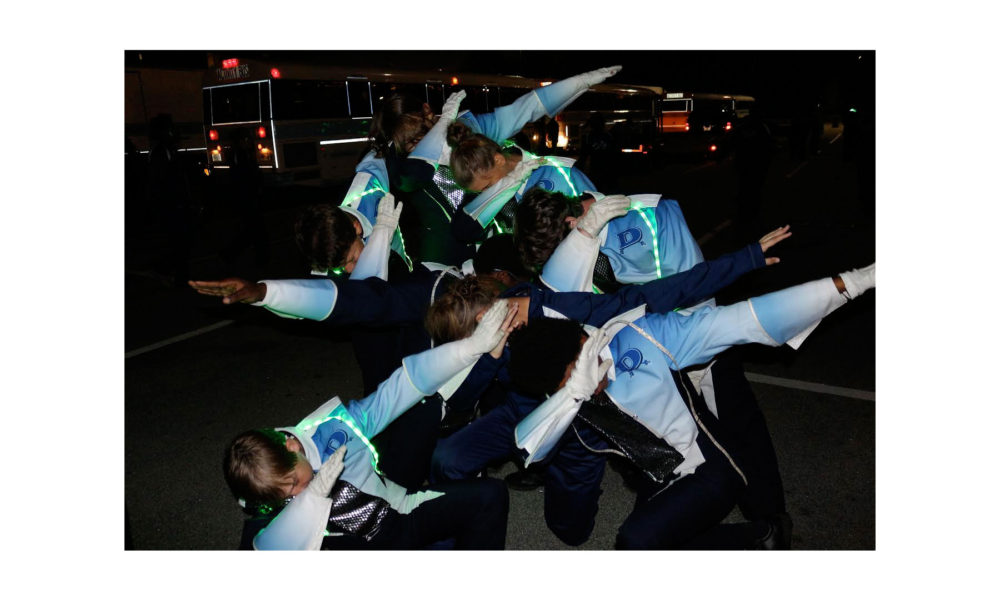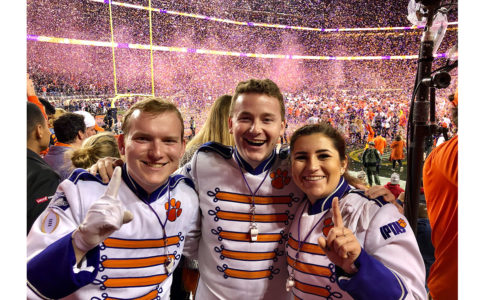Bands are jumping on the bandwagon of the latest online trends.
This past summer, the trumpet section at the University of Southern California (USC) Trojan Marching Band got a new member: Pidgey, a first-generation Pokémon. The Spirit of Troy tweeted a screenshot of the popular new game Pokémon Go, which placed Pidgey right next to USC’s line of trumpets. “If you’re doing a trend high school students are interested in, you’re going to get recruitment,” says Brett Padelford, USC director of public relations.
Whether it’s a college band recruiting new members, a military band spreading pride, or a high school band preparing for competition, every band incorporating popular music, dances, and social media trends has a common goal: to entertain, excite, and engage its audience.
Bands Say, “Watch Me!”
During the past two football seasons, bands around the country have been entertaining crowds with their renditions of Silentó’s 2015 hit, “Watch Me (Whip/Nae Nae).” “We try to be entertainers; popular music is the way in,” says Dr. Renardo Murray, director of bands at Alcorn State University in Lorman, Mississippi.
Alcorn State performed “Watch Me” at its 2015 game against Georgia Tech. During the dance, most wind players set their instruments down on the field, freeing their full bodies to dance to the drumline’s beat and the sousaphones’ melody.
After the game, the Alcorn State Band enjoyed positive responses from the show’s spectators and congratulatory emails from people who saw a video of the show posted to YouTube. “We [even] received emails from the Georgia Tech band,” Murray says.
During its 2016 game against Utah, the University of California, Berkeley, also incorporated Silentó’s song into its halftime show. The band opened its performance by spelling out “WATCH ME” on the field—both a call to the audience and a foreshadowing of the dance to come.
Instead of setting down their instruments and using their full bodies to dance as Alcorn State did, the Cal Band took a different approach to “Watch Me.” Wind players continued to play the melody on their instruments while incorporating subtle dance moves with their legs. “We focus on the smallest amounts of movement we can do to be coordinated but also get across what we’re doing,” says drum major Alexander Ewing.
Later in the show, 2,000 local high school students joined the Cal Band on the field for its High School Band Day tradition. They performed big-band renditions of famous dance tunes, like Walk the Moon’s “Shut Up and Dance” and the Village People’s “YMCA.”
Performing fun and popular music with high school students has long been a useful technique for driving recruitment within the Cal Band. “We reach out to the community and bring people together,” Ewing says. “[We] focus on the idea that music is an achievable goal after high school.”
Dance Break
In 2012, the USC band played a halftime show that would end up going viral on YouTube. Its Club Medley show featured hits like Rihanna’s “We Found Love” and Usher’s “Scream.” But one of the most memorable moments came toward the end when the band and cheerleaders broke out into the dance from PSY’s “Gangnam Style.”
In addition to the thunderous cheers and applause the band received at the game, the YouTube video of the performance earned almost 250,000 views. “You want to strike when the iron’s hot; get it publicized as quickly as you can,” says Padelford, who runs USC’s active Facebook, Twitter, Instagram, and Tumblr accounts.
Padelford’s strategy is to post the video to YouTube immediately, then blast a link to that video on all the other social media platforms. Padelford believes in the importance of staying on top of the latest trends, so that the performances feel exciting and fresh. “It can’t be contrived,” he says. “Relate it to the marching band however you can, so that you’re promoting the band and jumping on the bandwagon.”
Also gaining viral status on YouTube for its 2012 performance of “Gangnam Style” was the 3rd Marine Aircraft Wing Band—but in its case, the publicity was unintentional.
Each year, the band performs pre-ceremony entertainment at the Wing Birthday Ball, held on Nov. 10 to celebrate the birth of the U.S. Marine Corps in 1775. Historically, these musical performances have been traditional until the Wing Band decided to put a new spin on an old custom.
In 2011, the ensemble performed Queen’s “Bohemian Rhapsody,” earning a fantastic response from the Marines in the audience. “It really caught fire; it was so different than what we normally do,” says Master Sergeant Travis Antoine, the Wing Band’s bandmaster.
The 2012 Birthday Ball performance of “Gangnam Style” started off with one member singing an excerpt of the song and performing the dance in front of the other band members, who stood still behind him. Then, at the end of the song, the entire band joined in on the dance for a few seconds. “The crowd was going nuts,” Antoine says.
Averaging about 400 performances per year, the Wing Band certainly isn’t hurting for an audience, but it also didn’t expect the 3 million views this performance received on YouTube. “Our objective is not to gain publicity; it’s to spread goodwill,” Antoine says.
The incorporation of popular dances into marching shows has also made its way to the high school competition circuit. This past fall, Dorman High School in Roebuck, South Carolina, added the dab into its otherwise traditional show, titled “To Dance in the Secret Garden.”
Dave Bruce, Dorman’s marching band director, feels that mixing modern styles into a classical show both entertains the audience and impresses the judges at competitions. “The show itself is primarily based on a concert band piece, so the judges identify with that,” Bruce says. “But to mix in the hip-hop style just briefly, it was enough to touch base with [the audience] without losing sight of the competitive side of our show.”
The inspiration to use the dab specifically came from Carolina Panthers quarterback Cam Newton since the move would resonate with South Carolina audiences. “It’s one of his trademark moves; all our students would identify that with him,” Bruce says. “The judges also get a chuckle out of it.”
Mannequins and Mobs
2016 saw the rise of a new online fad: the Mannequin Challenge. As videos of people standing perfectly still, creating a scene as if they were mannequins, gained more and more attention on YouTube, marching bands started joining in on the fun.
For the Sacramento State Marching Band, a spontaneous decision before a performance resulted in tons of unexpected publicity. The band was warming up in a parking structure before a game when a staff volunteer recommended that they try the Mannequin Challenge. “We gave them a few minutes to improvise,” says Dr. Clay Redfield, associate director of bands at Sacramento State. “It ended up being enjoyable and got quite a bit of attention on social media.”
Soon after posting its video to YouTube, the band was contacted by its local NBC news affiliate. Though unexpected, this additional publicity hasn’t gone unappreciated since it has the potential to help with recruitment. “We hope that [for] students who might be considering our organization, that might bring us to their attention,” Redfield says.
Regardless of the publicity and recruitment benefits, Redfield’s greatest satisfaction comes from knowing that the students had a good time. “We didn’t think about what it might be,” he says. “We just thought it might be fun in the middle of a long day of hard work. It’s always nice that our students can get recognition for the work they do.”
A spur-of-the-moment decision in the midst of a long-scheduled performance also inspired the U.S. Air Force Band to try the Mannequin Challenge. Since 2013 the Air Force has taken part in a new tradition to create publicity: a holiday flash mob in Washington, D.C. “We wanted to generate buzz about our holiday concerts,” says Colonel Larry Lang, conductor of the Air Force Band. “We had no idea that it would go viral.”
A video of its 2013 flash mob got 300,000 hits within a day of its posting, so the holiday flash mob evolved into an annual tradition. Each year, the band breaks out into a surprise performance in the middle of a popular location, like the National Air and Space Museum or Union Station, for a crowd of unsuspecting spectators. This past year’s flash mob included a guest appearance by Deborah Lee James, Secretary of the Air Force, performing in the handbell choir.
At the end of the flash mob performance, Lang decided to attempt the Mannequin Challenge. The challenge included about 1,000 people—all members of the band, all members of the surprised audience, and Secretary James. “This is a high-level government official, and she didn’t know it was going to happen,” Lang says. “I took a chance, but she loved it. Success breeds success. We’re always trying to break new ground and do something new.”


